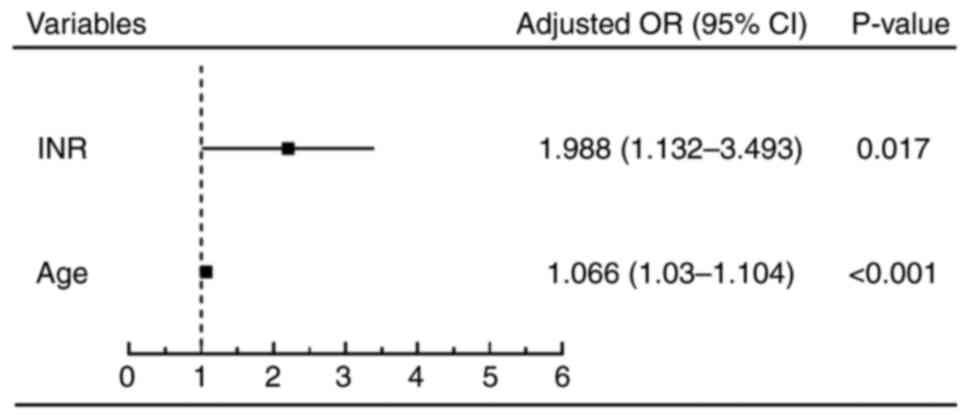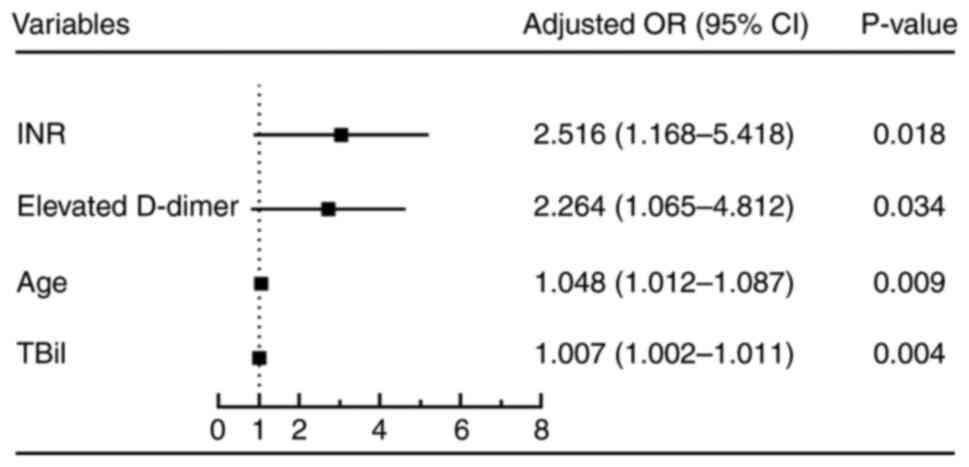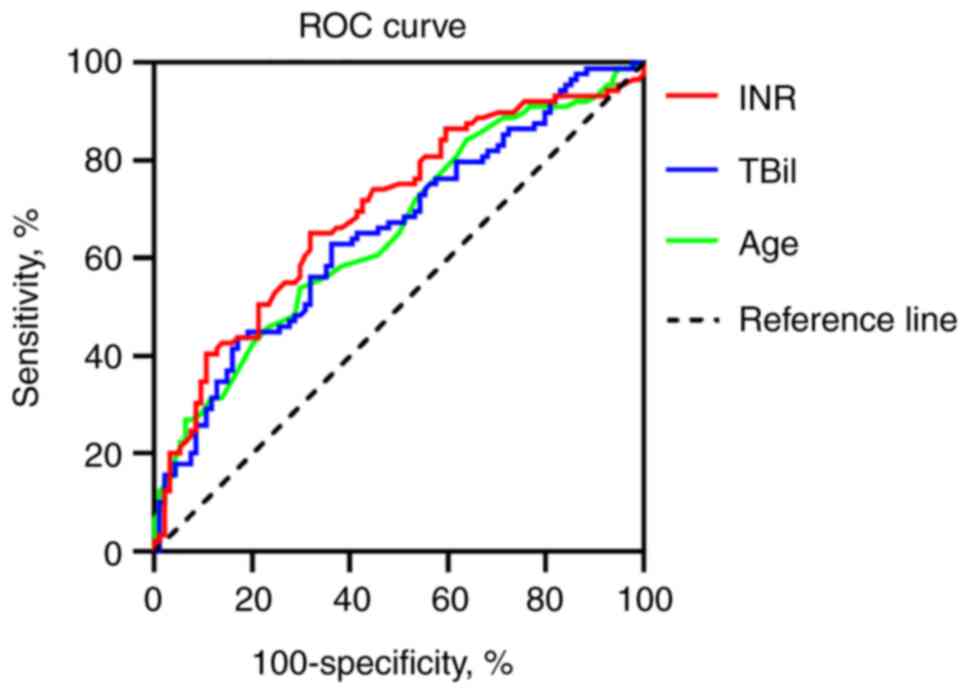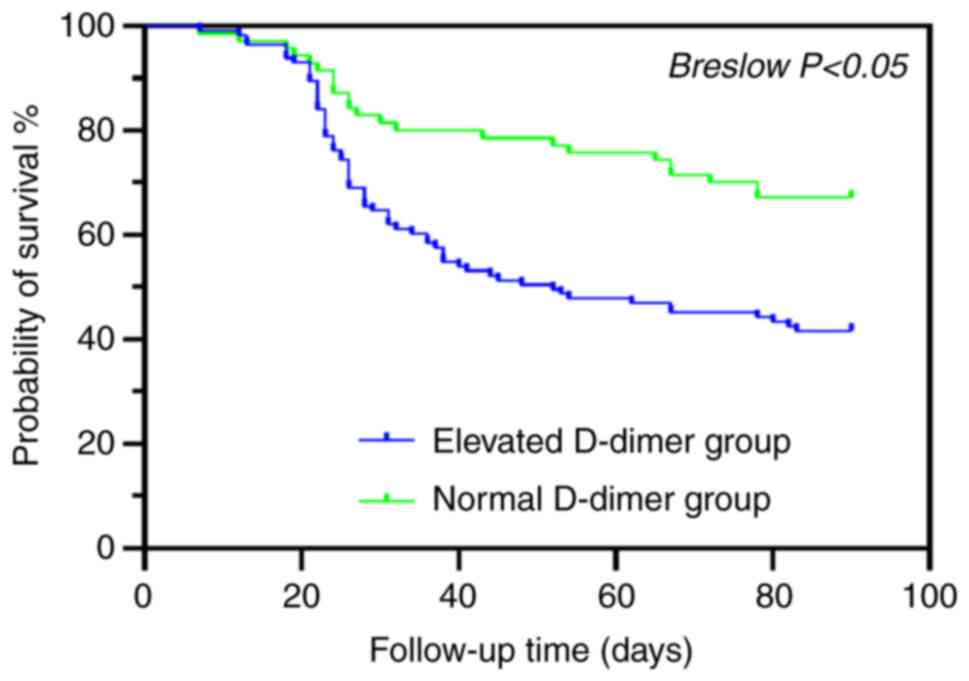|
1
|
Sarin SK, Choudhury A, Sharma MK, Maiwall
R, Al Mahtab M, Rahman S, Saigal S, Saraf N, Soin AS, Devarbhavi H,
et al: Correction to: Acute-on-chronic liver failure: Consensus
recommendations of the Asian Pacific association for the study of
the liver (APASL): An update. Hepatol Int. 13:826–828.
2019.PubMed/NCBI View Article : Google Scholar
|
|
2
|
Jalan R, Gines P, Olson JC, Mookerjee RP,
Moreau R, Garcia-Tsao G, Arroyo V and Kamath PS: Acute-on chronic
liver failure. J Hepatol. 57:1336–1348. 2012.PubMed/NCBI View Article : Google Scholar
|
|
3
|
Bajaj JS, O'Leary JG, Reddy KR, Wong F,
Biggins SW, Patton H, Fallon MB, Garcia-Tsao G, Maliakkal B, Malik
R, et al: Survival in infection-related acute-on-chronic liver
failure is defined by extrahepatic organ failures. Hepatology.
60:250–256. 2014.PubMed/NCBI View Article : Google Scholar
|
|
4
|
Bajaj JS, Moreau R, Kamath PS, Vargas HE,
Arroyo V, Reddy KR, Szabo G, Tandon P, Olson J, Karvellas C, et al:
Acute-on-chronic liver failure: Getting ready for prime time?
Hepatology. 68:1621–1632. 2018.PubMed/NCBI View Article : Google Scholar
|
|
5
|
Jalan R, Pavesi M, Saliba F, Amorós A,
Fernandez J, Holland-Fischer P, Sawhney R, Mookerjee R, Caraceni P,
Moreau R, et al: The CLIF consortium acute decompensation score
(CLIF-C ADs) for prognosis of hospitalised cirrhotic patients
without acute-on-chronic liver failure. J Hepatol. 62:831–840.
2015.PubMed/NCBI View Article : Google Scholar
|
|
6
|
Wlodzimirow KA, Eslami S, Abu-Hanna A,
Nieuwoudt M and Chamuleau RA: A systematic review on prognostic
indicators of acute on chronic liver failure and their predictive
value for mortality. Liver Int. 33:40–52. 2013.PubMed/NCBI View Article : Google Scholar
|
|
7
|
Saxena P, Bihari C, Rastogi A, Agarwal S,
Anand L and Sarin SK: Sonoclot signature analysis in patients with
liver disease and its correlation with conventional coagulation
studies. Adv Hematol. 2013(237351)2013.PubMed/NCBI View Article : Google Scholar
|
|
8
|
Lisman T and Porte RJ: Rebalanced
hemostasis in patients with liver disease: Evidence and clinical
consequences. Blood. 116:878–885. 2010.PubMed/NCBI View Article : Google Scholar
|
|
9
|
Blasi A, Calvo A, Prado V, Reverter E,
Reverter JC, Hernández-Tejero M, Aziz F, Amoros A, Cardenas A and
Fernández J: Coagulation failure in patients with acute-on-chronic
liver failure and decompensated cirrhosis: Beyond the international
normalized ratio. Hepatology. 68:2325–2337. 2018.PubMed/NCBI View Article : Google Scholar
|
|
10
|
Tripodi A, Primignani M, Chantarangkul V,
Dell'Era A, Clerici M, de Franchis R, Colombo M and Mannucci PM: An
imbalance of pro-vs anti-coagulation factors in plasma from
patients with cirrhosis. Gastroenterology. 137:2105–2111.
2009.PubMed/NCBI View Article : Google Scholar
|
|
11
|
Caldwell SH, Hoffman M, Lisman T, Macik
BG, Northup PG, Reddy KR, Tripodi A and Sanyal AJ: Coagulation in
Liver Disease Group. Coagulation disorders and hemostasis in liver
disease: Pathophysiology and critical assessment of current
management. Hepatology. 44:1039–1046. 2006.PubMed/NCBI View Article : Google Scholar
|
|
12
|
Qi T, Zhu C, Lu G, Hao J, He Q, Chen Y,
Zhou F, Chen J and Hou J: Elevated D-dimer is associated with
increased 28-day mortality in acute-on-chronic liver failure in
China: A retrospective study. BMC Gastroenterol.
19(20)2019.PubMed/NCBI View Article : Google Scholar
|
|
13
|
Weitz JI, Fredenburgh JC and Eikelboom JW:
A test in context: D-dimer. J Am Coll Cardiol. 70:2411–2420.
2017.PubMed/NCBI View Article : Google Scholar
|
|
14
|
Drolz A, Horvatits T, Roedl K, Rutter K,
Staufer K, Kneidinger N, Holzinger U, Zauner C, Schellongowski P,
Heinz G, et al: Coagulation parameters and major bleeding in
critically ill patients with cirrhosis. Hepatology. 64:556–568.
2016.PubMed/NCBI View Article : Google Scholar
|
|
15
|
Gram J, Duscha H, Zurborn KH and Bruhn HD:
Increased levels of fibrinolysis reaction products (D-dimer) in
patients with decompensated alcoholic liver cirrhosis. Scand J
Gastroenterol. 26:1173–1178. 1991.PubMed/NCBI View Article : Google Scholar
|
|
16
|
Cioni G, Cristani A, Mussini C, Grandi S,
Pentore R, Zeneroli ML, Tizzanini W, Zagni G and Ventura E:
Incidence and clinical significance of elevated fibrin(ogen)
degradation product and/or D-dimer levels in liver cirrhosis
patients. Ital J Gastroenterol. 22:70–74. 1990.PubMed/NCBI
|
|
17
|
Li Y, Qi X, Li H, Dai J, Deng H, Li J,
Peng Y, Liu X, Sun X and Guo X: D-dimer level for predicting the
in-hospital mortality in liver cirrhosis: A retrospective study.
Exp Ther Med. 13:285–289. 2017.PubMed/NCBI View Article : Google Scholar
|
|
18
|
Zhou J, Mao W, Shen L and Huang H: Plasma
D-dimer as a novel biomarker for predicting poor outcomes in
HBV-related decompensated cirrhosis. Medicine (Baltimore).
98(e18527)2019.PubMed/NCBI View Article : Google Scholar
|
|
19
|
Liver Failure and Artificial Liver Group,
Chinese Society of Infectious Diseases, Chinese Medical
Association; Severe Liver Disease and Artificial Liver Group,
Chinese Society of Hepatology, Chinese Medical Association.
Guideline for diagnosis and treatment of liver failure. Zhonghua
Gan Zang Bing Za Zhi. 27:18–26. 2019.PubMed/NCBI View Article : Google Scholar : (In Chinese).
|
|
20
|
Yin J and Tian L: Joint confidence region
estimation for area under ROC curve and Youden index. Stat Med.
33:985–1000. 2014.PubMed/NCBI View
Article : Google Scholar
|
|
21
|
Fimognari FL, De Santis A, Piccheri C,
Moscatelli R, Gigliotti F, Vestri A, Attili A and Violi F:
Evaluation of D-dimer and factor VIII in cirrhotic patients with
asymptomatic portal venous thrombosis. J Lab Clin Med. 146:238–243.
2005.PubMed/NCBI View Article : Google Scholar
|
|
22
|
Violi F, Ferro D, Basili S, Quintarelli C,
Musca A, Cordova C and Balsano F: Hyperfibrinolysis resulting from
clotting activation in patients with different degrees of
cirrhosis. The CALC group. Coagulation abnormalities in liver
cirrhosis. Hepatology. 17:78–83. 1993.PubMed/NCBI
|
|
23
|
El Gohary AM, Elyamany AS, Mikhael NL,
Mahmoud MG and Tawfik MMR: Serum and ascitic D-dimer in cirrhotic
patients with spontaneous bacterial peritonitis. Clin Exp Hepatol.
7:134–140. 2021.PubMed/NCBI View Article : Google Scholar
|
|
24
|
Eidelberg A, Kirubakaran R, Nair SC, Eapen
CE, Elias E and Goel A: Systematic review: Role of elevated plasma
von-Willebrand factor as predictor of mortality in patients with
chronic liver disease. Eur J Gastroenterol Hepatol. 31:1184–1191.
2019.PubMed/NCBI View Article : Google Scholar
|
|
25
|
Piano S, Bartoletti M, Tonon M,
Baldassarre M, Chies G, Romano A, Viale P, Vettore E, Domenicali M,
Stanco M, et al: Assessment of Sepsis-3 criteria and quick SOFA in
patients with cirrhosis and bacterial infections. Gut.
67:1892–1899. 2018.PubMed/NCBI View Article : Google Scholar
|
|
26
|
Fernández J, Acevedo J, Wiest R, Gustot T,
Amoros A, Deulofeu C, Reverter E, Martínez J, Saliba F, Jalan R, et
al: Bacterial and fungal infections in acute-on-chronic liver
failure: Prevalence, characteristics and impact on prognosis. Gut.
67:1870–1880. 2018.PubMed/NCBI View Article : Google Scholar
|
|
27
|
Moreau R, Jalan R, Gines P, Pavesi M,
Angeli P, Cordoba J, Durand F, Gustot T, Saliba F, Domenicali M, et
al: Acute-on-chronic liver failure is a distinct syndrome that
develops in patients with acute decompensation of cirrhosis.
Gastroenterology. 144:1426–1437.e1-e9. 2013.PubMed/NCBI View Article : Google Scholar
|
|
28
|
Rittirsch D, Flierl MA and Ward PA:
Harmful molecular mechanisms in sepsis. Nat Rev Immunol. 8:776–787.
2008.PubMed/NCBI View
Article : Google Scholar
|
|
29
|
Prasanna KS, Goel A, Amirtharaj GJ,
Ramachandran A, Balasubramanian KA, Mackie I, Zachariah U, Sajith
KG, Elias E and Eapen CE: Plasma von Willebrand factor levels
predict in-hospital survival in patients with acute-on-chronic
liver failure. Indian J Gastroenterol. 35:432–440. 2016.PubMed/NCBI View Article : Google Scholar
|
|
30
|
Lisman T, Arefaine B, Adelmeijer J,
Zamalloa A, Corcoran E, Smith JG, Bernal W and Patel VC: Global
hemostatic status in patients with acute-on-chronic liver failure
and septics without underlying liver disease. J Thromb Haemost.
19:85–95. 2021.PubMed/NCBI View Article : Google Scholar
|



















